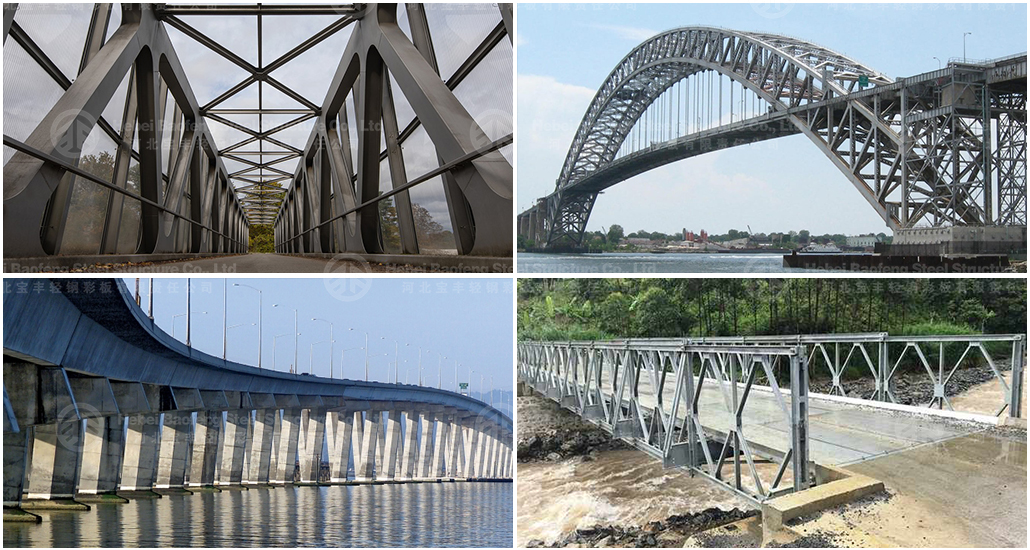
Steel Section Bridge Competitive Advantage
Steel section bridges offer several competitive advantages over other types of bridge construction materials, such as concrete, timber, or composite materials. These advantages make steel section bridges a preferred choice for many infrastructure projects, especially in modern engineering and transportation systems. Here are the key competitive advantages of steel section bridges:
1. High Strength-to-Weight Ratio
Lightweight yet Strong: Steel has an exceptional strength-to-weight ratio, allowing for the construction of long-span bridges with minimal material usage. This reduces the overall weight of the bridge, which simplifies foundation design and reduces construction costs.
Efficient Load-Bearing Capacity: Steel sections can efficiently carry heavy loads, making them ideal for highways, railways, and other high-traffic applications.
2. Speed of Construction
Prefabrication: Steel sections are often prefabricated in factories, which allows for rapid assembly on-site. This significantly reduces construction time compared to traditional materials like concrete, which require curing time.
Minimized On-Site Work: The use of prefabricated steel sections reduces the need for extensive on-site labor, speeding up the construction process and minimizing disruptions to traffic or the surrounding environment.
3. Durability and Longevity
Corrosion Resistance: Modern steel bridges are often coated with protective layers (e.g., galvanizing, painting, or advanced coatings) to resist corrosion, ensuring a long service life even in harsh environments.
Low Maintenance: Steel bridges require less maintenance compared to other materials, reducing long-term operational costs. Periodic inspections and minor repairs are often sufficient to maintain their structural integrity.
4. Flexibility in Design
Aesthetic Appeal: Steel bridges can be designed to be visually striking, with sleek and modern aesthetics. Their flexibility allows for innovative and artistic designs, making them suitable for urban and scenic locations.
Customizable Shapes and Sizes: Steel sections can be easily shaped and assembled into complex geometries, allowing for unique and functional designs that meet specific project requirements.
5. Cost-Effectiveness
Lower Material Costs: Steel is often more cost-effective than other materials, especially for long-span bridges, due to its high strength and lightweight properties.
Reduced Construction Time: Faster construction times translate into lower labor costs and reduced project delays, making steel bridges a cost-effective option.
Long-Term Savings: The durability and low maintenance requirements of steel bridges result in significant long-term cost savings.
6. Sustainability
Recyclability: Steel is 100% recyclable, making it an environmentally friendly choice for bridge construction. Recycled steel can be reused in new projects, reducing the demand for virgin materials.
Energy Efficiency: Steel production has become more energy-efficient over time, and its lightweight nature reduces the energy required for transportation and construction.
7. Seismic and Wind Resistance
Ductility: Steel is highly ductile, meaning it can deform under stress without breaking. This property makes steel bridges highly resistant to seismic activity, making them ideal for earthquake-prone regions.
Wind Resistance: Steel bridges can be designed to withstand high winds, making them suitable for coastal or open areas.
8. Adaptability for Modern Infrastructure
Compatibility with Other Materials: Steel can be combined with other materials (e.g., concrete) to create hybrid structures that leverage the strengths of both materials.
Integration with Modern Technologies: Steel bridges can be equipped with advanced technologies, such as sensors for structural health monitoring, to ensure safety and efficiency.
9. Environmental Benefits
Reduced Carbon Footprint: The use of steel in bridge construction can reduce the carbon footprint compared to other materials, especially when recycled steel is used.
Minimal Environmental Impact: Steel bridges have a smaller environmental impact during construction due to their lightweight nature and reduced need for heavy machinery.
10. Global Availability and Standardization
Widespread Availability: Steel is a globally available material, making it easy to source for projects in any location.
Standardized Manufacturing: Steel sections are manufactured to strict standards, ensuring consistent quality and performance across different projects.
Applications of Steel Section Bridges
Steel section bridges are widely used in various applications, including:
Highway Bridges: For long spans and high traffic loads.
Railway Bridges: For their strength and durability.
Pedestrian Bridges: For their aesthetic appeal and lightweight design.
Industrial Bridges: For their ability to handle heavy loads and harsh environments.
Temporary or Modular Bridges: For their ease of assembly and disassembly.
Conclusion
Steel section bridges offer a unique combination of strength, durability, speed of construction, and design flexibility, making them a competitive choice for modern infrastructure projects. Their cost-effectiveness, sustainability, and adaptability to modern technologies further enhance their appeal, ensuring their continued use in the construction of bridges worldwide.

Категории
последний блог
Теги
© авторское право: 2025 Hebei Baofeng Steel Structure CO.,LTD Все права защищены.

IPv6 сеть поддерживается